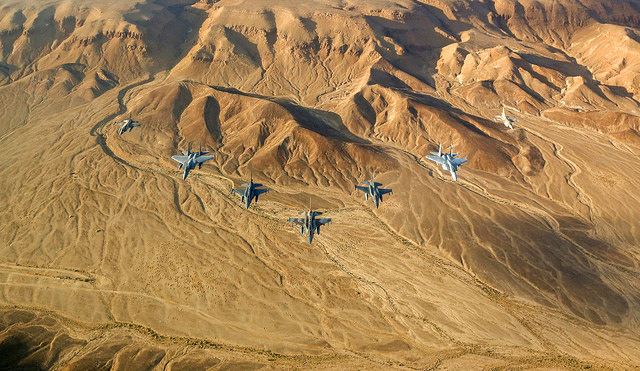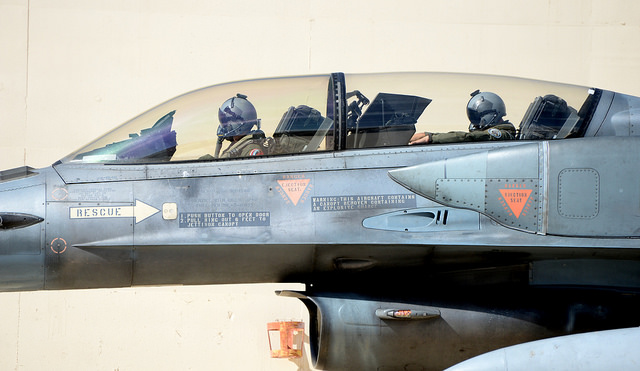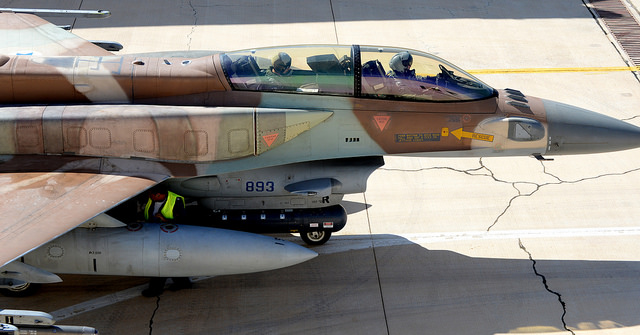Hundreds of participants, dozens of aircraft and one airbase: the largest aerial training exercise in the history of the Israel Air Force has come to an end and elevated the skill level of its participants to new heights.
By: Shachar Zorani, Eylon Tohar and Eliyah Levitan. Translation: Ohad Zelter-Zubida.
The largest aerial training exercise in the history of the IAF has come to an end: 245 sorties, 102 aircrew members, 416 technicians, administrative and support workers and 54 aircraft from all over the world took part in the “Blue-Flag 2015” training exercise, and practiced complex combat scenarios in unexpected weather conditions, in extremely high intensity and in multiple different languages.
The “Blue-Flag” is a comprehensive international training exercise held for the second time this year, with the participation of the United States Air Force, the Polish Air Force, the Hellenic Air Force and other foreign Air Forces. The goal of the exercise was to simulate extreme combat scenarios and fly in coalition as realistically as possible.

(Photos: www.iaf.org.il)
Extreme Combat Training at a High-Quality Playground
The foreign squadrons together with the Israeli Air Force simulated a war situation in which targets were destroyed. The exercise lasted two weeks, with the first week’s goal being the foreign participant’s acclimation to the “Uvda” Airbase and mental acclimation to the intensity of the exercise. In the second week the level of intensity rose, as the forces practiced a complex military campaign against the “enemy forces” that were simulated by the Israeli “Aggressors” – the”Flying Dragon” squadron.
“The Middle East is a fickle area,” said “Flying Dragon” squadron Commander, Lt. Col. A. “We face the development of various enemy coalitions and we have to be able to face each one. The training playground that was dedicated to the exercise extended across the entire country, and was as complex as possible as the level of difficulty rose each day.”
“The “Aggressors” squadron simulated SAM (surface-to-air missile) batteries, SFM (shoulder fired missile) units, and enemy aircraft in order to provide an extreme and challenging aerial threat.
The designers of the exercise promised a more complex and challenging exercise than the previous one, and they definitely rose to expectations. For the first time, the participants practiced night flights and aerial refueling missions. In addition, integrated forces were added to the exercise, included helicopters, electronic warfare, heavy transport and airborne air traffic control, so that besides air-to-air missions and air-to-ground missions, the crews also practiced missions supporting the activity of the combat division.
“We built a high quality and challenging training playground which combined all of the challenges of the operational field,” shares Lt. Col. Udi. “The ‘Blue-Flag’ exercise is the IAF’s flagship exercise, hosting the best Israeli and foreign squadrons participated.”
IAF Commander, Maj. Gen Amir Eshel, attended the fourth day of the exercise and took part in a formation sortie, the first formation in the exercise that included both American and Israeli crews. The IAF Commander explained the strategic importance of the exercise to the participants. On the Israeli side flew two F-15 squadrons, two F-16I (“Sufa”) squadrons and two F-16C/D (“Barak”) squadrons, alongside heavy transport squadrons, helicopters and electronic warfare. The foreign participants brought F-15 and F-16 jets.
“Learning from joint exercises is extremely beneficial. You fly together and share your military doctrines,” said Head of IAF Air Division, Brig. Gen. Nir Barkan. “At the end of the day, the challenges that Air Forces across the world face are similar. This is the second time that we have led an exercise of this magnitude and we plan on hosting one every two years. We have piqued interest worldwide, and additional countries have requested to join the exercise.”

“Blue-Flag 2015”: a Perfect Environment for International Cooperation
The exercise has become an international point of interest: 24 foreign attaches from all over the globe toured the “Uvda” Airbase over the past two weeks. An additional 34 foreign observers from countries that did not participate in the exercise this year also came. Among the observers were members of the Czech, German, Canadian, French, Romanian and British Air Force, members of the USAFE, The American Marines, and even the Austrian Air Force Commander.
“Blue-Flag” is a strategic exercise on the national level”, explains Lt. Col. Tomer. “The Israeli Air Force is in the top league of Air Forces in the world. We may not be members of NATO, but we speak the language and know how to get the work done, so if we will ever be needed in operational activity abroad, we will definitely know how to execute the mission to the best of our abilities.”
The Polish Air Force Inspector, Maj. Gen. Jan Sliwka also flew in the exercise alongside the “Knights of the Orange Tail” Squadron. “Our objective is simply to fly,” said Maj. Gen. Sliwka after landing. “This is the second “Blue-Flag” exercise, and this year, the scenarios are better, and the “Uvda” Airbase presented us with optimal conditions for practice. We learned a lot from one another, shared experiences, and also had the opportunity to experience Israeli culture.”
The cooperation between the Israeli Air Force and its Polish counterpart has strengthened significantly, with 2015 being a record year for close collaboration. “The Polish Air Force cooperates with the Israeli Air Force in many fields,” added Maj. Gen. Jan Sliwka. “There are many similarities and we learn a lot from the Israeli pilots.”
“The exercise is a great opportunity for us,” added Major J, a pilot in the Hellenic Air Force. “During the exercise we received the opportunity to cooperate with multiple countries that have an abundance of operational experience and to simulate operational scenarios with them,” explained Major J.
This is the first time that Major J took part in “Blue-Flag” and he was impressed by the cooperation with the other participating countries. “The exercise brings together many countries that have different cultures, different languages and different tactics. The synchronization and coordination was complicated and challenging, but it allows us to observe the abilities of other air forces. We learned from them and they learned from us.”

“No plane could take off without the technical division”
The foreign squadrons that landed at “Uvda” Airbase were welcomed by renovated HAS (hardened aircraft shelter), painted structures, available ground services and full fuel reserves. This was all prepared in advance by the Airbase’s Maintenance Squadron. “An exercise of this extent requires much more preparation,” noted Major A, commander of the Maintenance Squadron. “The amount of aircraft was immense, and the HASs were highly active, leading to increased activity of the squadron. We had to always be available and use all of our resources,” he said. “No plane could take off without the technical division.”
“The key to success is all the preparations we made toward to exercise which started almost a year ago,” explained Major A. The preparations included many training sessions, augmentation and mobilization of resources and renovation of infrastructures. But that was just the preparation. Technical crews worked extra hours during the exercise itself. “Reservists were called in to assist the soldiers in the squadron. The career soldiers also stayed late to meet the demands.”
The aircrew members were not the only ones to cooperate with the foreign forces. Many technicians and maintenance workers were also flown in to take part in the exercise. “The cooperation with the foreign technicians was excellent,” boasted Major A. “During the meetings preceding the exercise we coordinated the resources allocation, work methods, and maintenance methods of all forces,” he said. The Israeli Maintenance Squadron provided all the general needs for each force – electricity, fuel, water and equipment. This training exercise is a wonderful opportunity for mutual learning and growth.”
“Uvda” Airbase, the hosting airbase of “Blue Flag,” underwent months of preparations before hosting the hundreds of people and carrying out the immense number of sorties. “The people of “Uvda” did an amazing job. They managed to give us full and great support,” concluded Lt. Col. Tomer.
Original article appeared on http://www.iaf.org.il/